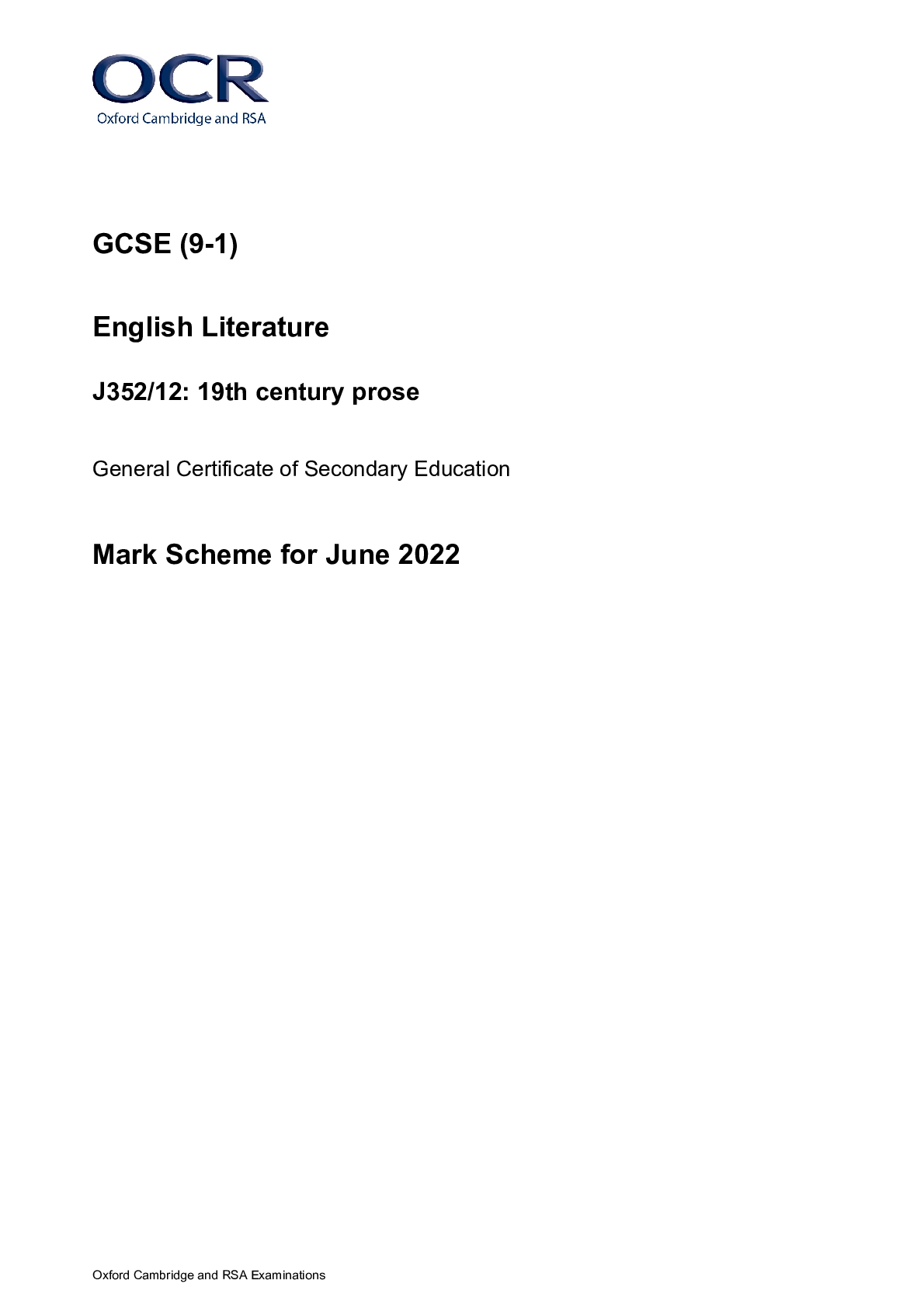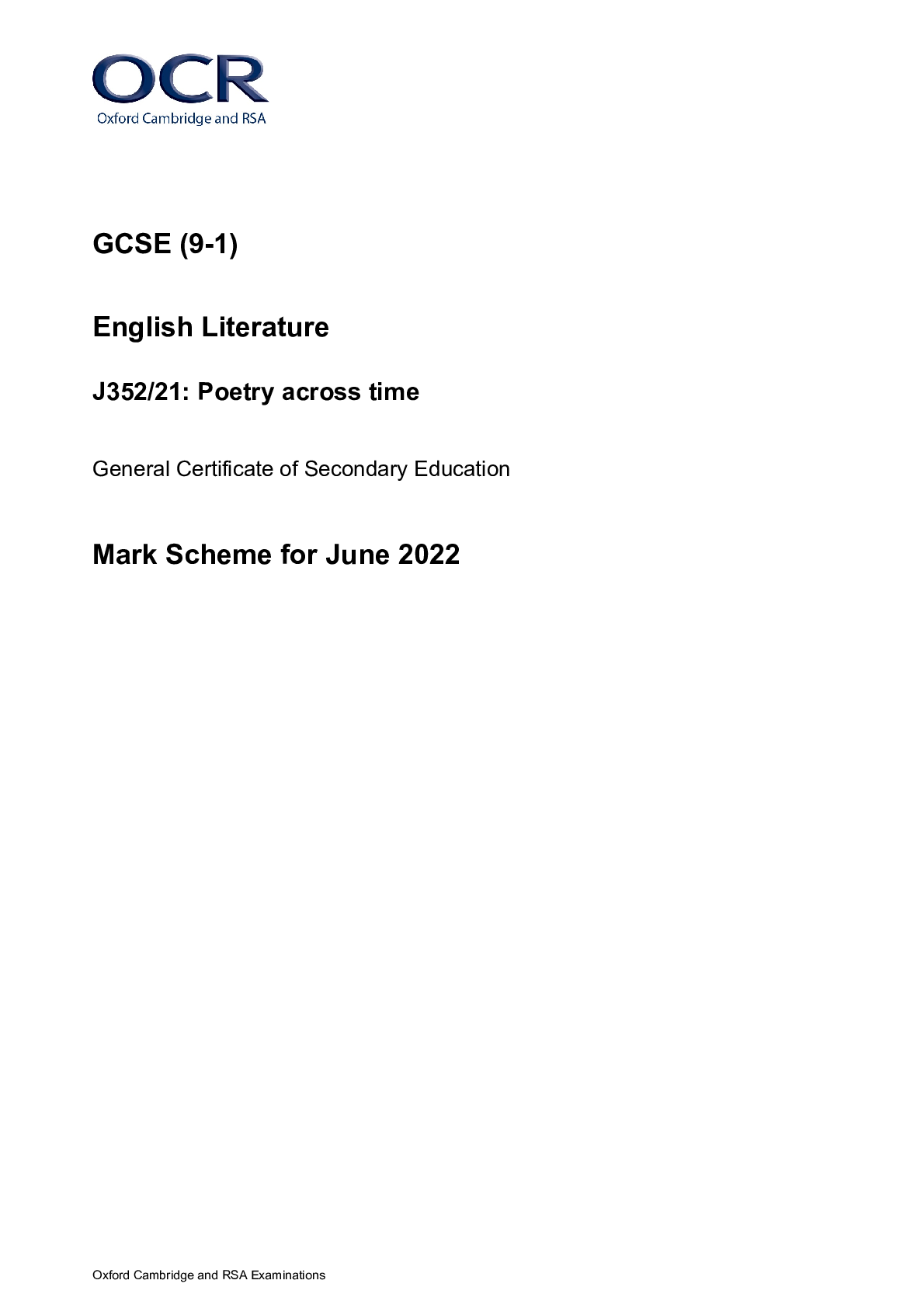Economics > GCSE MARK SCHEME > GCSE (9–1) Economics J205/02: National and international economics General Certificate of Secondar (All)
GCSE (9–1) Economics J205/02: National and international economics General Certificate of Secondary Education Mark Scheme for November 2020
Document Content and Description Below
GCSE (9–1) Economics J205/02: National and international economics General Certificate of Secondary Education Mark Scheme for November 2020 Oxford Cambridge and RSA Examinations GCSE (9–1)... Economics J205/02: National and international economics General Certificate of Secondary Education Mark Scheme for November 2020Oxford Cambridge and RSA Examinations OCR (Oxford Cambridge and RSA) is a leading UK awarding body, providing a wide range of qualifications to meet the needs of candidates of all ages and abilities. OCR qualifications include AS/A Levels, Diplomas, GCSEs, Cambridge Nationals, Cambridge Technicals, Functional Skills, Key Skills, Entry Level qualifications, NVQs and vocational qualifications in areas such as IT, business, languages, teaching/training, administration and secretarial skills. It is also responsible for developing new specifications to meet national requirements and the needs of students and teachers. OCR is a not-for-profit organisation; any surplus made is invested back into the establishment to help towards the development of qualifications and support, which keep pace with the changing needs of today’s society. This mark scheme is published as an aid to teachers and students, to indicate the requirements of the examination. It shows the basis on which marks were awarded by examiners. It does not indicate the details of the discussions which took place at an examiners’ meeting before marking commenced. All examiners are instructed that alternative correct answers and unexpected approaches in candidates’ scripts must be given marks that fairly reflect the relevant knowledge and skills demonstrated. Mark schemes should be read in conjunction with the published question papers and the report on the examination. © OCR 2020J205/02 Mark Scheme November 2020 2 Annotations Annotation Meaning Tick Cross Unclear Benefit of the doubt Irrelevant Level one Level two Level three Not answered questionJ205/02 Mark Scheme November 2020 3 Own figure rule Noted but no credit given. Too vague Omission mark BP Blank page Highlighting is also available to highlight any particular points on the script. BP to be inserted on every blank page ‘SEEN’ to be inserted in every question space where NR is the mark.J205/02 Mark Scheme November 2020 4 Levels of response / Level descriptors Knowledge and understanding Application Analysis Evaluation Good Good knowledge and understanding of the theory stated or referred to in the question. All of the terms/theoretical concepts are explicitly or implicitly understood. Good application of knowledge to a given scenario. The terms/theoretical concepts are used/adapted/changed in the context of the given scenario. There is good understanding of all the relevant elements of the scenario. Good analysis of the effect of xxxx. There is correct analysis in the form of developed links. These links are developed through a chain of reasoning which addresses the question. Any relevant diagram(s) are predominantly correct and linked to the analysis. Good evaluation with a fully supported judgement that is developed from a weighing up arguments/both sides/comparing alternatives. Reasonable Reasonable knowledge and understanding of the theory stated or referred to in the question. Most of the terms/theoretical concepts are explicitly or implicitly understood. Reasonable application of knowledge to a given scenario. The terms/theoretical concepts are used/adapted/changed in the context of the given scenario. There is understanding of some the relevant elements of the scenario. Reasonable analysis of the effect on xxxx. There is correct analysis largely in the form of single effects. These address the question but are not developed into a clear chain of reasoning. The relevant diagram(s), if present, may be improperly labelled or not linked to the analysis. Reasonable evaluation of xxx considering arguments/both sides/comparing alternatives. There may be a judgement but this will not be fully supported. Limited Limited knowledge and understanding of the theory stated or referred to in the question. Some of the terms/theoretical concepts are explicitly or implicitly understood. Limited application of knowledge to a given scenario. There is an attempt to use/adapt/change the terms/theoretical concepts in the context. Limited analysis of the effect on xxxx. There is an attempt at analysis which may include a single effect that has some link to the question. Diagrams (if present) are unlikely to be correct and not linked to the analysis. Limited evaluation of xxx that may include an incomplete consideration of arguments/both sides/comparing alternatives with unsupported statements.J205/02 Mark Scheme November 2020 5 Section A Question Key AO Quantitative skills 1 D AO1b 2 B AO2 √ 3 C AO2 4 A AO2 √ 5 B AO1b 6 D AO1a 7 C AO2 √ 8 A AO1b 9 B AO1b 10 B AO1b 11 B AO1b 12 D AO1b 13 D AO2 √ 14 A AO2 15 A AO1aJ205/02 Mark Scheme November 2020 6 Question Key AO Quantitative skills 16 C AO2 √ 17 D AO1b 18 A AO1b 19 C AO1b 20 C AO1aJ205/02 Mark Scheme November 2020 7 Section B Question Indicative content Marks Guidance 21 (a) Explain why the UK public sector had to borrow £35.9 billion. Answers may include: • Government spending is too high • Tax revenues are too low • Government spending is higher than tax revenue or vice versa 2 AO2 1 mark for each of the first two bullet points OR 2 marks for the third bullet point (b) Explain why government spending on unemployment benefits has been falling. Answers may include: • the number of strictly defined unemployed has fallen either because a) the economy/output/GDP is growing OR b) there are more opportunities for working on zero hours contracts or in part time or in irregular employment • the claimant procedure has become stricter and thus payments per person have fallen • there are more people who have left the labour force either because they are discouraged or because they have retired as the population is ageing. 2 AO1b 1 mark for a valid reason. +1 mark for explaining the reason. If two connected reasons are stated without explanation, 2 marks may be awarded. Any other reasonable answer to be credited.J205/02 Mark Scheme November 2020 8 (c) Analyse how UK government spending on health could affect the economy. Answers may include: • because health spending is a major part of government spending (two thirds of government spending is devoted to three items of which one is health), it has a direct positive impact on aggregate demand and so increases output, economic growth and employment • when the population is healthy the overall economy is more productive • the social and economic environment is better when there is less suffering than would have occurred when people could not afford to pay for doctors or medicine. Therefore, society has chosen to ensure that everyone has access to free medical care • without government spending there would be market limitations, because the health industry has positive externalities (benefits for people who are not directly participating in the market) by keeping families and workers healthy and by limiting the spread of infectious diseases • by correcting market limitations through government spending, resource allocation becomes closer to optimum • health spending provides funds for research into treatments, which would otherwise not be profitable if produced wholly by private companies. • less competition in public health provision than if health services were supplied through markets, which possibly could lead to inefficient allocation of resources and to a lack of innovation • difficulty in allocating scarce resources, since no price signals from interaction of Demand and Supply • because health spending is a major part of government spending (two thirds of government spending is devoted to 1 AO1a 2 AO2 3 AO3a All level descriptors describe the TOP of the level – please read guidance at the beginning of the mark scheme regarding best fit approach. Level 3 (5-6 marks) (AO1a – 1, AO2 – 2 marks, AO3a – 3 marks = 6 marks) Reasonable knowledge and understanding of health spending and the economic impact. All of the terms/theoretical concepts are explicitly or implicitly understood. Reasonable application of knowledge about health spending and the economic impact. The terms/theoretical concepts are used/adapted/changed in the context of the given scenario. There is understanding of some the relevant elements of the scenario. Good analysis of why there needs to be government spending to correct market limitationsThere is correct analysis in the form of developed links. These links are developed through a chain of reasoning which addresses the question. Any relevant diagram(s) are predominantly correct and linked to the analysis. Level 2 (3-4 marks) (AO1a – 1 mark, AO2 – 1 mark, AO3a – 2 marks = 4 marks) Reasonable knowledge and understanding. Most of the terms/theoretical concepts are explicitly or implicitly understood. Limited application of knowledge about health spendingJ205/02 Mark Scheme November 2020 9 three items of which one is health) there are higher taxes (direct and indirect), which may distort other markets (e.g. labour markets) and the economic impact. There is an attempt to use/adapt/change the terms/theoretical concepts in the context. Reasonable analysis of why there needs to be government spending to correct market limitations, but with some adverse effects. There is correct analysis largely in the form of single effects. These address the question but are not developed into a clear chain of reasoning. The relevant diagram(s), if present, may be imperfectly labelled or not linked to the analysis. Level 1 (1-2 marks) (AO1a – 1 mark, AO2 – 0 marks, AO3a – 1 mark = 2 marks) Reasonable knowledge and understanding. Some of the terms/theoretical concepts are explicitly or implicitly understood. No application of knowledge about health spending and the economic impact. There is an attempt to use/adapt/change the terms/theoretical concepts in the context. Limited analysis of why there needs to be government spending to correct market limitations, but with some adverse effects. There is an attempt at analysis which may include a single effect that has some link to the question. Diagrams (if present) are unlikely to be correct and not linked to the analysis. 0 marks No response or no work worthy of credit.J205/02 Mark Scheme November 2020 10 N.B. Any other relevant points and/or evidence of learners’ understanding of the connections between the various topics of both components to be credited. (d) (i) Using the table in Extract 1, calculate how much income tax is paid by someone earning £20,000. Show your working. 0 + 20 100 × (20,000 – 11,850) = 1,630 £1,630 2 AO2 2 marks for correct answer on its own, which must include the £ sign. 1 mark for correct working, but incorrect answer. Correct answer on its own without £ sign is worth 1 mark only. (ii) Give two examples of positive externalities that arise from government spending. Answers may include: • Improved health e.g.when vaccinations prevent the spread of contagious diseases to those who are not vaccinated • Lower crime e.g. when communities benefit from children and youths being educated • When families participate fully in society after receiving child benefits • Improved air quality e.g. when spending on parks benefits many in the community. • Lower congestion e.g when spending on bridges • 2 AO1a 1 mark for each valid answer up to a maximum of 2 marks. Any other reasonable answer to be credited. *(iii) Evaluate the consequences of using taxes and other measures to redistribute income in the UK. Use the information given in Extract 1 on page 9 and your own knowledge. Adverse consequences may include: • disincentive to earn extra income which would put one’s earnings into a higher band • migration of highly paid workers who are seeking to avoid taxes 1 AO2 2 AO3a 3 AO3b All level descriptors describe the TOP of the level – please read guidance at the beginning of the mark scheme regarding best fit approach. Level 3 (5-6 marks) (AO2 – 1, AO3a – 2 marks, AO3b – 3 marks = 6 marks) Good application of knowledge to the scenario of progressive taxes, benefits and their consequences. TheJ205/02 Mark Scheme November 2020 11 • opportunity costs occur from providing social benefits • one third of government spending (£184.5 billion from April to December) went to benefits, a measure to redistribute income, which have to be paid for by higher taxes or borrowing • difficulty in making social benefits “fair”, as shown by controversy over universal credit • may become politicised Beneficial consequences may include: • redistribution of income to reduce income inequalities through both taxes and social benefits is a policy generally agreed upon by society • living in a more equal society increases happiness (and total utility) • total consumption is higher because those with low incomes consume more of their income, which leads to higher economic growth/AD shifting right • more tax revenue from progressive taxes (if additional tax rates are sufficiently high), which can then be used to fund merit goods (education etc) • when economy is in recession, tax burden automatically falls (social benefits rise) as incomes and employment fall • when economy is inflationary, tax burden automatically rises (social benefits fall) as incomes and employment rise • (discretionary) changes in taxes and social benefits can be used as part of fiscal policy to manage the economy Evaluation may include: • Difficult to isolate the effects of progressive taxes and benefits from the effects of other policies, such as education, or from economic or social issues, such as growth etc • Reliable data to prove effectiveness of benefits also difficult to obtain terms/theoretical concepts are used/adapted/changed in the context of the given scenario. There is good understanding of all the relevant elements of the scenario. Reasonable analysis of consequences of progressive taxes and benefits. There is correct analysis largely in the form of single effects. These address the question but are not developed into a clear chain of reasoning. The relevant diagram(s), if present, may be imperfectly labelled or not linked to the analysis. Good evaluation of the consequences of progressive taxes and benefits with a fully supported judgement that is developed from weighing up arguments/both sides/comparing alternatives. There is a well-developed and detailed line of reasoning which is coherent and logically structured. The information presented is entirely relevant and substantiated. Level 2 (3-4 marks) (AO2 – 1, AO3a – 1 mark, AO3b – 2 marks = 4 marks) Good application of knowledge to the scenario of progressive taxes, benefits and their consequences. The terms/theoretical concepts are used/adapted/changed in the context of the given scenario. There is good understanding of all the relevant elements of the scenario. Limited analysis of consequences of progressive taxes and benefits. There is an attempt at an analysis largely in the form of a single effect. These address the question but are not developed into a clear chain of reasoning. The relevant diagram(s), if present, are unlikely to be correct and notJ205/02 Mark Scheme November 2020 12 • The overall effect may be difficult to discern (i.e. whether costs or benefits are larger), but benefits outweigh costs according to overall assessment by society of mixed market economies that provide education and health benefits to society. linked to the analysis. Reasonable evaluation of the consequences of progressive taxes and benefits considering arguments/both sides/comparing alternatives. There may be a judgement but this will not be fully supported. There is a line of reasoning presented with some structure. The information presented is in the most-part relevant and supported by some evidence. Level 1 (1-2 marks) (AO2 – 0 marks, AO3a – 1 mark, AO3b – 1 mark = 2 marks) No application of knowledge about the consequences of progressive taxes and benefits. There is an attempt to use/adapt/change the terms/theoretical concepts in the context. Limited analysis of the consequences of progressive taxes and benefits. There is an attempt at analysis which may include a single effect that has some link to the question. Diagrams (if present) are unlikely to be correct and not linked to the analysis. Limited evaluation of the consequences of progressive taxes and benefits that may include an incomplete consideration of arguments/both sides/comparing alternatives with unsupported statements. Information presented is basic and may be ambiguous or unstructured. The information is supported by limited evidence.J205/02 Mark Scheme November 2020 13 0 marks No response or no work worthy of credit. N.B. Any other relevant points and/or evidence of learners’ understanding of the connections between the various topics of both components to be credited. Question Indicative content Marks Guidance 22 (a) Explain what is meant by economic growth. Economic growth is usually measured by the GDP growth rate. When real gross domestic product increases, there are more goods and services. This means that the economy is producing more (households are earning more), so living standards are rising. The increase/change in GDP (1) over time (1) 2 AO1a 1 mark for explaining the link with the GDP growth rate. 1 mark for explaining the link with goods and services OR output OR living standards. Any other reasonable answer to be credited. (b) Calculate the UK’s per capita GDP in 2015. Show your working. 2,055,991.7 x 1,000,000 65,128,861 = 31,568.0581 £31,568.1 2 AO2 2 marks for correct answer on its own, which must include the £ sign. Correct answer on its own without £ sign is worth 1 mark only. 1 mark for correct working, but incorrect answer. (c) Using the information in Extract 2 on page 13, analyse the differences between Uganda’s GDP per capita and the UK’s GDP per capita from 2015 to 2017. Answers may include: 1 AO1a 2 AO2 3 AO3a All level descriptors describe the TOP of the level – please read guidance at the beginning of the mark scheme regarding best fit approach. Level 3 (5-6 marks) (AO1a – 1, AO2 – 2 marks, AO3a – 3 marks = 6 marks)J205/02 Mark Scheme November 2020 14 • Uganda is a less developed country, so its GDP per capita is significantly lower than the UK’s. e.g. in 2017 $ 666.6 is much lower than $ 42,514.5; • UK’s GDP per capita is about 60 times greater than Uganda’s. • Uganda is a primary producer (agriculture) with low value added, while the UK economy is based on high-value added secondary (manufacturing) and increasingly tertiary (services) output. • But from 2015 to 2017 Uganda’s economic (real GDP) growth rate is higher than the UK’s, partly because it is starting from a much lower level • Uganda’s economy is benefiting from better communications, which enables the transfer of technology • Improved communications also lead to more trading possibilities • Compared to the UK, therefore, its economy is growing rapidly and is becoming more manufacturing and services oriented • Now, however, Uganda’s economic growth rate is slowing down from 5.2% to 4%, as it becomes more developed • Uganda’s rate of population growth is higher than the UK’s, as life expectancy is rising. Therefore, its GDP per capita grows at a much lower rate than its economic growth rate. Per capita growth in GDP is only around 1% each year. Reasonable knowledge and understanding of development issues that affect GDP per capita over time. All of the terms/theoretical concepts are explicitly or implicitly understood. Reasonable application of knowledge about GDP per capita. The terms/theoretical concepts are used/adapted/changed in the context of the given scenario. There is understanding of some the relevant elements of the scenario. Good analysis of why there are differences in GDP per capita between countries and over time. There is correct analysis in the form of developed links. These links are developed through a chain of reasoning which addresses the question. Any relevant diagram(s) are predominantly correct and linked to the analysis. Level 2 (3-4 marks) (AO1a – 1 mark, AO2 – 1 mark, AO3a – 2 marks = 4 marks) Reasonable knowledge and understanding. Most of the terms/theoretical concepts are explicitly or implicitly understood. Limited application of knowledge about GDP per capita. There is an attempt to use/adapt/change the terms/theoretical concepts in the context. Reasonable analysis of why there are differences in GDP per capita between countries and over time. There is correct analysis largely in the form of single effects. These address the question but are not developed into a clear chain of reasoning. The relevant diagram(s), if present, may beJ205/02 Mark Scheme November 2020 15 imperfectly labelled or not linked to the analysis. Level 1 (1-2 marks) (AO1a – 1 mark, AO2 – 0 marks, AO3a – 1 mark = 2 marks) Reasonable knowledge and understanding. Some of the terms/theoretical concepts are explicitly or implicitly understood. No application of knowledge about GDP per capita. There is an attempt to use/adapt/change the terms/theoretical concepts in the context. Limited analysis of why there are differences in GDP per capita between countries and over time. There is an attempt at analysis which may include a single effect that has some link to the question. Diagrams (if present) are unlikely to be correct and not linked to the analysis. 0 marks No response or no work worthy of credit. N.B. Any other relevant points and/or evidence of learners’ understanding of the connections between the various topics of both components to be credited. (d) (i) Explain how economic growth has an impact on the environment. Answers may include: • Pollution from factories is higher when there is economic growth based on industrialisation 2 AO1b 1 mark for a stated bullet point or example. 2 marks for providing an explained bullet point (i.e. words after…..).J205/02 Mark Scheme November 2020 16 • Carbon emissions from energy use and transportation increase with economic growth • Natural resources may be used up (e.g. oil, copper) • Congestion occurs on roads and at ports • Impact on ecological systems (water, birds etc) is often adverse • Better technology from growth could improve the environment, e.g. new recycling techniques or clean energy methods Any other reasonable answer to be credited. (ii) Explain why economic growth is often considered to be beneficial in the UK. Answers may include: • because living standards rise as more goods and services become available • because incomes usually rise as employment increases with economic growth • because higher incomes and profits will lead to more tax revenue and lower benefit payments, which should lower government borrowing • because more government revenue will enable more spending on public services and environmental protection 2 AO2 1 mark for a stated bullet point. 2 marks for providing an explained bullet point (i.e. words after….). Any other reasonable answer to be credited. *(iii) Evaluate the costs of economic growth in the UK. Use the information given in Extract 2 on page 13 and your own knowledge. Costs may include: • Negative externalities from polluting industries and more travel by car and plane, which increase carbon emissions • More use of plastic and more waste • More use of finite resources, especially energy • Higher inflation, which could affect business confidence and penalise those on fixed incomes or those whose wages do not rise in line with inflation 1 AO2 2 AO3a 3 AO3b All level descriptors describe the TOP of the level – please read guidance at the beginning of the mark scheme regarding best fit approach. Level 3 (5-6 marks) (AO2 – 1, AO3a – 2 marks, AO3b – 3 marks = 6 marks) Good application of knowledge to the scenario of economic growth and its costs. The terms/theoretical concepts are used/adapted/changed in the context of the given scenario. There is good understanding of all the relevant elements ofJ205/02 Mark Scheme November 2020 17 • Higher interest rates, which would penalise those needing loans for housing and reduce the incentive to invest and so reduce future economic growth • More unequal income distribution as those in productive industries obtain higher wages/incomes Evaluation may include: • Partly depends on how economic growth is achieved, e.g. whether or not through high polluting industries or through investment in new technologies with less negative externalities, such as renewable energy sources • When the UK growth rate falls, unemployment rises and tax revenues decrease, so there is more government debt and then austerity. • Therefore, economic growth, despite its negative aspects, is necessary to improve living standards. Focus should be on the kind of economic growth and the associated transport requirements • Short, medium and long term effects are different. For example, investment in renewable energy sources is a longterm solution to lowering the costs of economic growth. the scenario. Reasonable analysis of costs of economic growth. There is correct analysis largely in the form of single effects. These address the question but are not developed into a clear chain of reasoning. The relevant diagram(s), if present, may be imperfectly labelled or not linked to the analysis. Good evaluation of costs in contrast to benefits of economic growth with a fully supported judgement that is developed from weighing up arguments/both sides/comparing alternatives. There is a well-developed and detailed line of reasoning which is coherent and logically structured. The information presented is entirely relevant and substantiated. Level 2 (3-4 marks) (AO2 – 1, AO3a – 1 mark, AO3b – 2 marks = 4 marks) Good application of knowledge to the scenario of economic growth and its costs. The terms/theoretical concepts are used/adapted/changed in the context of the given scenario. There is good understanding of all the relevant elements of the scenario. Limited analysis of costs of economic growth. There is an attempt at an analysis largely in the form of a single effect. These address the question but are not developed into a clear chain of reasoning. The relevant diagram(s), if present, are unlikely to be correct and not linked to the analysis. Reasonable evaluation of the costs in contrast to benefitsJ205/02 Mark Scheme November 2020 18 of economic growth considering arguments/both sides/comparing alternatives. There may be a judgement but this will not be fully supported. There is a line of reasoning presented with some structure. The information presented is in the most-part relevant and supported by some evidence. Level 1 (1-2 marks) (AO2 – 0 marks, AO3a – 1 mark, AO3b – 1 mark = 2 marks) No application of knowledge about the costs of economic growth. There is an attempt to use/adapt/change the terms/theoretical concepts in the context. Limited analysis of the costs of economic growth. There is an attempt at analysis which may include a single effect that has some link to the question. Diagrams (if present) are unlikely to be correct and not linked to the analysis. Limited evaluation of the costs in contrast to benefits of economic growth that may include an incomplete consideration of arguments/both sides/comparing alternatives with unsupported statements. Information presented is basic and may be ambiguous or unstructured. The information is supported by limited evidence. 0 marks No response or no work worthy of credit. N.B. Any other relevant points and/or evidence ofJ205/02 Mark Scheme November 2020 19 learners’ understanding of the connections between the various topics of both components to be credited. Question Indicative content Marks Guidance 23 (a) Using the data in Extract 3, calculate the total trade balance for 2018 Q3. Show your working. 88,884 + 69,721 – 123,880 – 43,508 = − 8,783 − £8,783 million OR “deficit is £8,783 million” 2 AO2 2 marks for correct answer on its own, which must include the £ sign and the minus sign or refer to a deficit. Correct answer on its own without £ sign and/or minus sign or deficit is worth 1 mark only. 1 mark for correct working, but incorrect answer. (b) Using the data in Extract 3, calculate the percentage change in exports of goods between 2018 Q2 and 2018 Q3. Show your working. .( 88,884 85,987 − 1) x 100 = 3,3691 OR (88884-85987) / 85987 x 100 3.37% OR 3.4% 2 AO2 2 marks for correct answer with correct percentage sign. Correct answer on its own with no percentage sign is worth 1 mark only. 1 mark for correct working, but incorrect answer. (c) Using Extract 3, on page 16, analyse the causes of the persistent current account deficit in the UK. Answers may include: 1 AO1a 2 AO2 3 AO3a All level descriptors describe the TOP of the level – please read guidance at the beginning of the mark scheme regarding best fit approach. Level 3 (5-6 marks) (AO1a – 1 mark, AO2 – 2 marks, AO3a – 3 marks = 6J205/02 Mark Scheme November 2020 20 • Other countries’ productivity gains in manufacturing and competitive power have resulted in slower growth in UK exports. • Services growth has not yet compensated for slow growth in goods exports • Improvement in UK incomes over time has led to higher demand for imports • Low-cost imports, e.g. from China, are attractive to British companies and consumers • Overseas manufacturers have increased their productivity compared to the UK, e.g. steel • The exchange rate of the pound (£) may be too high, which has hampered exports, but benefited imports • Inflation rate may be higher in the UK than in its trading partners • Because of foreign investment in the UK economy, net investment income is a growing debit item (nearly £11 million in 2018 Q3). Additional factors: • UK is a net borrower from the rest of the world, so financial inflows finance the deficit on its current account • UK is increasingly selling its assets (shares etc.) to overseas investors • The surplus (inflow from foreign investors) on the financial account finances the deficit on the current account, though that does lead to investment income being negative. marks) Reasonable knowledge and understanding about current account deficit. All of the terms/theoretical concepts are explicitly or implicitly understood. Reasonable application of knowledge to the data on current account deficit. The terms/theoretical concepts are used/adapted/changed in the context of the given scenario. There is understanding of some the relevant elements of the scenario. Good analysis of causes of current account deficit. There is correct analysis in the form of developed links. These links are developed through a chain of reasoning which addresses the question. Any relevant diagram(s) are predominantly correct and linked to the analysis. There is a well-developed and detailed line of reasoning which is coherent and logically structured. The information presented is entirely relevant and substantiated. Level 2 (3-4 marks) (AO1a – 1 mark, AO2 – 1 mark, AO3a – 2 marks = 4 marks) Reasonable knowledge and understanding. Most of the terms/theoretical concepts are explicitly or implicitly understood. Limited application of knowledge to the data on current account deficit. There is an attempt to use/adapt/change the terms/theoretical concepts in the context. Reasonable analysis of causes of current account deficit..J205/02 Mark Scheme November 2020 21 There is correct analysis largely in the form of single effects. These address the question, but are not developed into a clear chain of reasoning. Any relevant diagram(s) may be imperfectly labelled or not linked to the analysis. Level 1 (1-2 marks) (AO1a – 1 mark, AO2 – 0 marks, AO3a – 1 mark = 2 marks) Reasonable knowledge and understanding. Some of the terms/theoretical concepts are explicitly or implicitly understood. No application of knowledge about the cause of current account deficit. There is an attempt to use/adapt/change the terms/theoretical concepts in the context. Limited analysis of the causes of a current account deficit. There is an attempt at analysis which may include a single effect that has some link to the question. Diagrams (if present) are unlikely to be correct and not linked to the analysis. 0 marks No response or no work worthy of credit. N.B. Any other relevant points and/or evidence of learners’ understanding of the connections between the various topics of both components to be credited. (d) (i) Explain what is meant by a free trade agreement. Answers may include: • There are no import tariffs or quotas on goods and services that enter one country from another country in the group • The countries in the group can trade with countries outside 2 AO1a 1 mark for stating no tariffs or quotas for countries within FTA. 1 mark for stating that countries within FTA can make own trade deals with countries outside FTA OR for providingJ205/02 Mark Scheme November 2020 22 the area in any way they wish • Free Trade Agreement: Free movement of goods and services between countries, without any restrictions.Examples are NAFTA and EFTA. correct example. Any other reasonable answer to be credited. (ii) Explain one cost to producers of globalisation. Answers may include: • More competition (competing with imports from lower cost producers overseas), which might be harmful to domestic producers whose productivity is lower • Some loss of stability if projects are financed by overseas investors who may, if political and economic conditions change, withdraw their investments • Producers who cannot participate in international supply chains will tend to decline 2 AO1b 1 mark for stating a cost which is not explained. 2 marks for providing an explained cost. Any other reasonable answer to be credited. *(iii) Evaluate the benefits of globalisation to producers in the UK. Use the information given in Extract 3, on page XX, and your own knowledge. Benefits may include: • Larger markets, beyond UK domestic market, could lead to specialisation and economies of scale, which would lower average production costs • More opportunities to participate in supply chains both with foreign companies locating in the UK or with companies overseas • Less form filling and customs delays when globalisation includes freer trade or removal of tariffs (and non-tariff barriers) • More opportunities to benefit from technology and innovation worldwide • More skilled workers from overseas could improve productivity among UK producers • More foreign tourists visit UK, which could help local 1 AO2 2 AO3a 3 AO3b All level descriptors describe the TOP of the level – please read guidance at the beginning of the mark scheme regarding best fit approach. Level 3 (5-6 marks) (AO2 – 1, AO3a – 2 marks, AO3b – 3 marks = 6 marks) Good application of knowledge to the scenario of globalisation and its benefits. The terms/theoretical concepts are used/adapted/changed in the context of the given scenario. There is good understanding of all the relevant elements of the scenario. Reasonable analysis of beneficial effects on producers of globalisation. There is correct analysis largely in the form of single effects. These address the question but are not developed into a clear chain of reasoning. The relevant diagram(s), if present, may be imperfectly labelled or notJ205/02 Mark Scheme November 2020 23 economies and the hospitality industry • Higher economic growth from trade and foreign investment should lead to higher incomes, so consumption of goods and services made by UK producers should widen and increase • Corporate taxes are likely to be more equal across economies if globalisation is accompanied by tax negotiations and reform Evaluation may include: • Total UK trade has increased by about eight times since 1983 (calculated from the data in the text), which demonstrates how significant globalisation is to the UK economy. • While there are political and environmental concerns about globalisation, on balance UK producers benefit as long as they innovate and compete with improved productivity • Globalisation should overall have benefits for economic growth and employment, though in the short term there may be adjustment difficulties • Those producers who cannot compete globally will need assistance either through technical transfers or through managing their decline and the re-employment of their workers • There may be structural decline and unemployment in certain regions that have not been able to participate in international supply chains, which should be balanced against the benefits • Producers may find that their employees are resentful about working alongside foreigners, so there will need to be social and economic policies that ensure that UK employees do not feel “left behind”. • Necessary for UK government to adopt policies to ensure that multinationals cannot avoid taxes, because such avoidance would be unfair with respect to UK producers linked to the analysis. Good evaluation of effects on producers of globalisation with a fully supported judgement that is developed from weighing up arguments/both sides/comparing alternatives. There is a well-developed and detailed line of reasoning which is coherent and logically structured. The information presented is entirely relevant and substantiated. Level 2 (3-4 marks) (AO2 – 1, AO3a – 1 mark, AO3b – 2 marks = 4 marks) Good application of knowledge to the scenario of globalisation and its benefits. The terms/theoretical concepts are used/adapted/changed in the context of the given scenario. There is good understanding of all the relevant elements of the scenario. Limited analysis of beneficial effects on producers of globalisation. There is an attempt at an analysis largely in the form of a single effect. These address the question but are not developed into a clear chain of reasoning. The relevant diagram(s), if present, are unlikely to be correct and not linked to the analysis. Reasonable evaluation of effects on producers of globalisation, considering arguments/both sides/comparing alternatives. There may be a judgement but this will not be fully supported. There is a line of reasoning presented with some structure. The information presented is in the most-part relevant and supported by some evidence.J205/02 Mark Scheme November 2020 24 Level 1 (1-2 marks) (AO2 – 0 marks, AO3a – 1 mark, AO3b – 1 mark = 2 marks) No application of knowledge about globalisation. There is an attempt to use/adapt/change the terms/theoretical concepts in the context. Limited analysis of the beneficial effects on producers of globalisation. There is an attempt at analysis which may include a single effect that has some link to the question. Diagrams (if present) are unlikely to be correct and not linked to the analysis. Limited evaluation of the effects on producers of globalisation that may include an incomplete consideration of arguments/both sides/comparing alternatives with unsupported statements. Information presented is basic and may be ambiguous or unstructured. The information is supported by limited evidence. 0 marks No response or no work worthy of credit. N.B. Any other relevant points and/or evidence of learners’ understanding of the connections between the various topics of both components to be credited.OCR (Oxford Cambridge and RSA Examinations) The Triangle Building Shaftesbury Road Cambridge CB2 8EA [Show More]
Last updated: 1 year ago
Preview 1 out of 26 pages
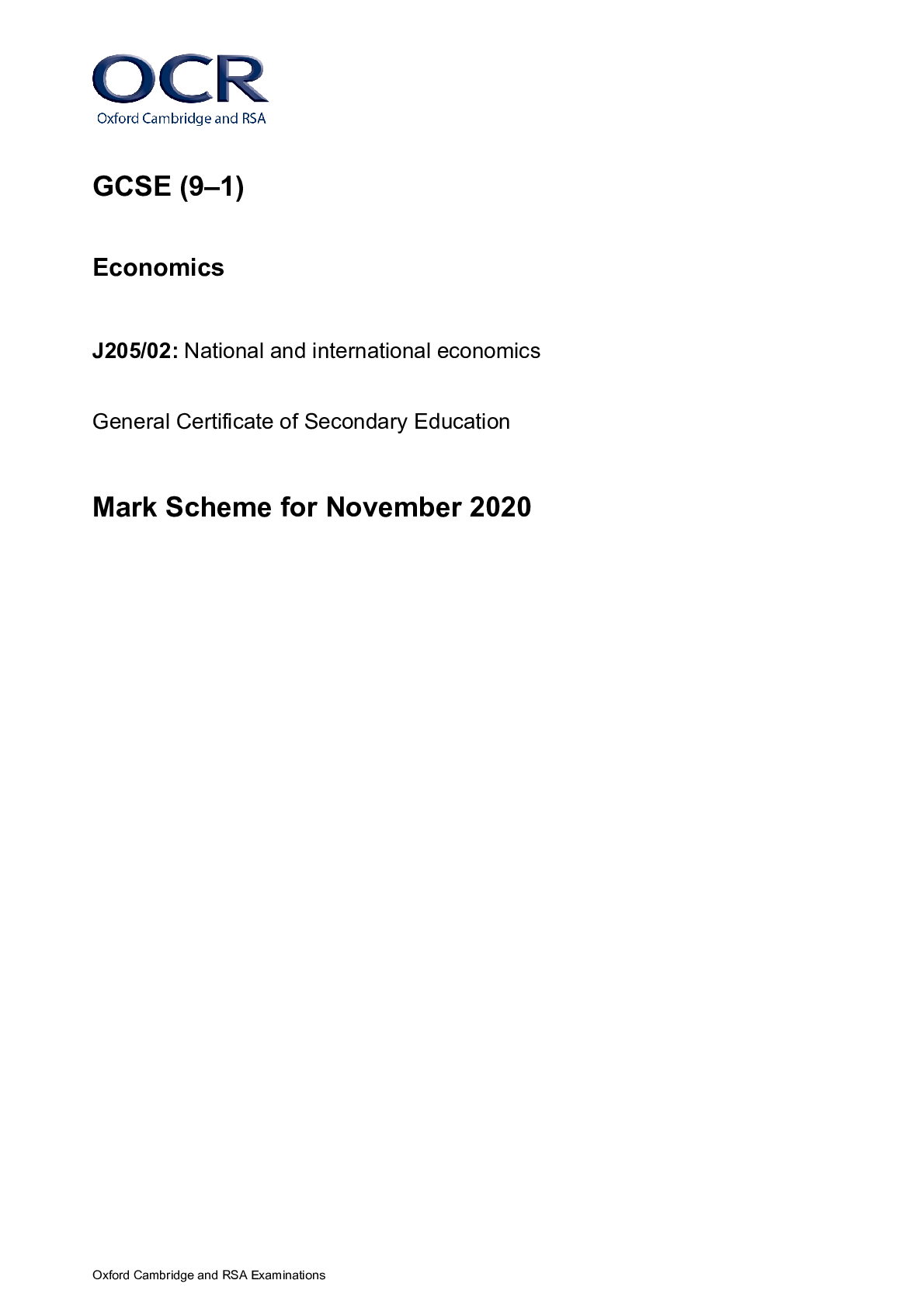
Reviews( 0 )
Document information
Connected school, study & course
About the document
Uploaded On
Oct 07, 2022
Number of pages
26
Written in
Additional information
This document has been written for:
Uploaded
Oct 07, 2022
Downloads
0
Views
61



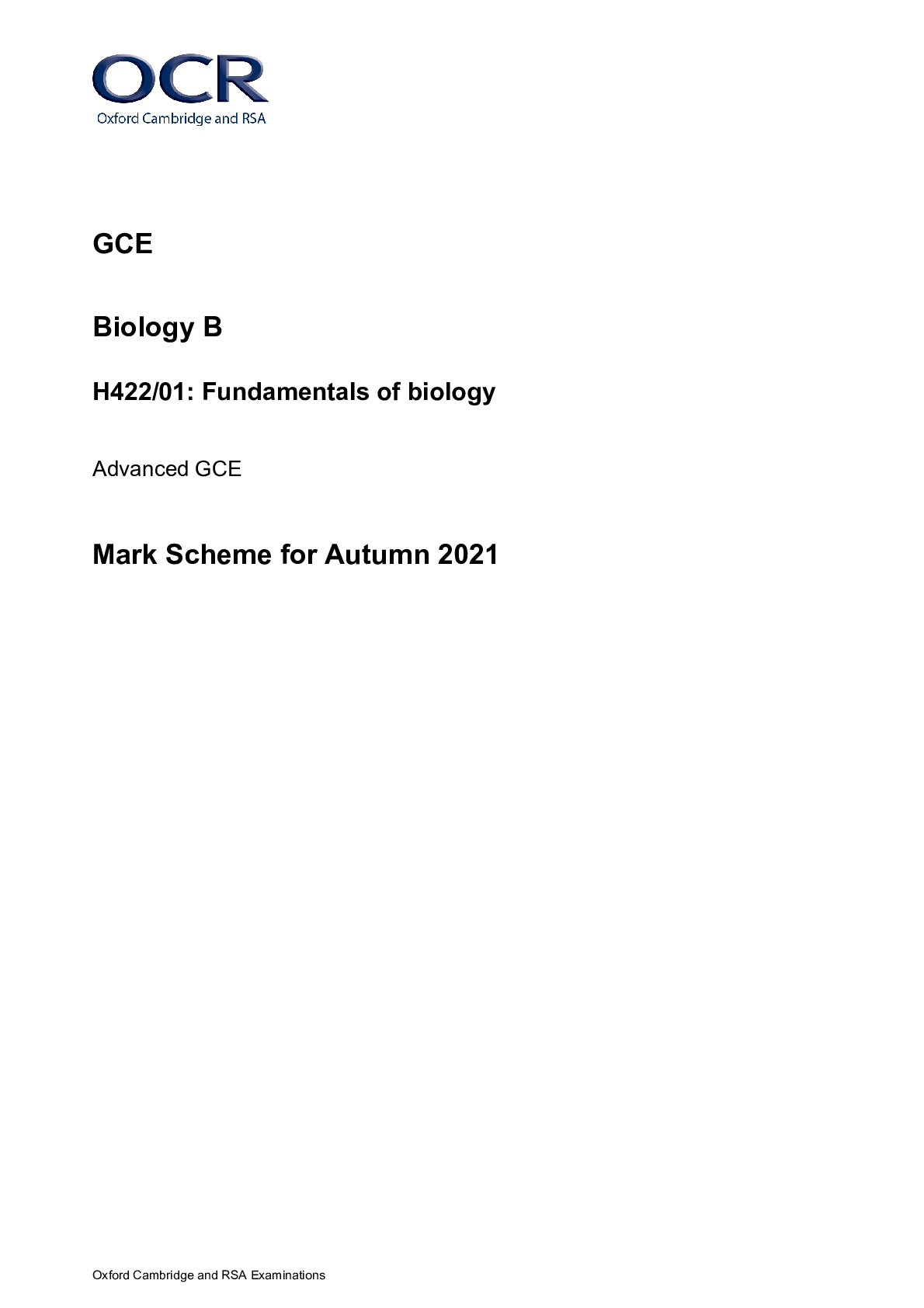
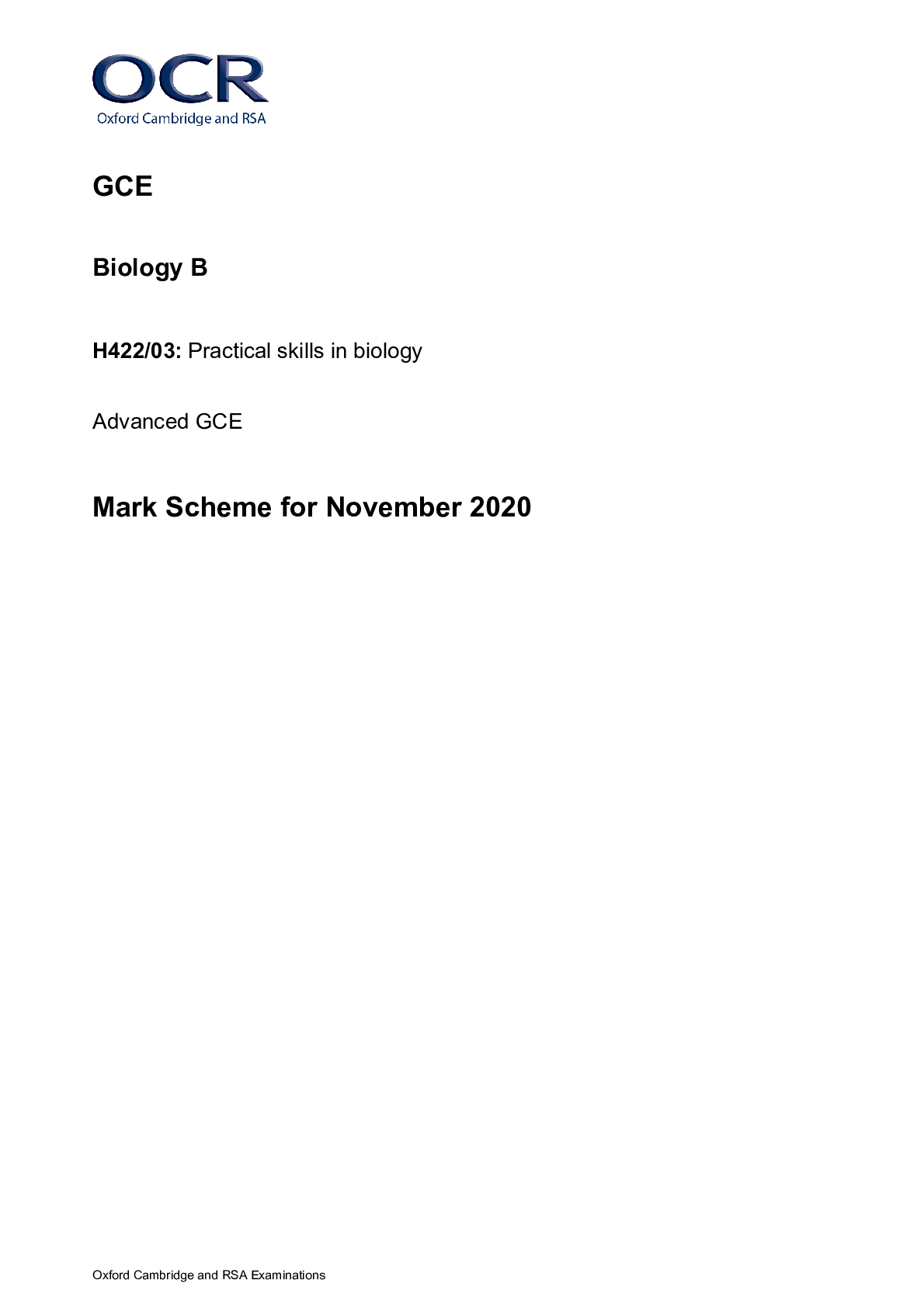
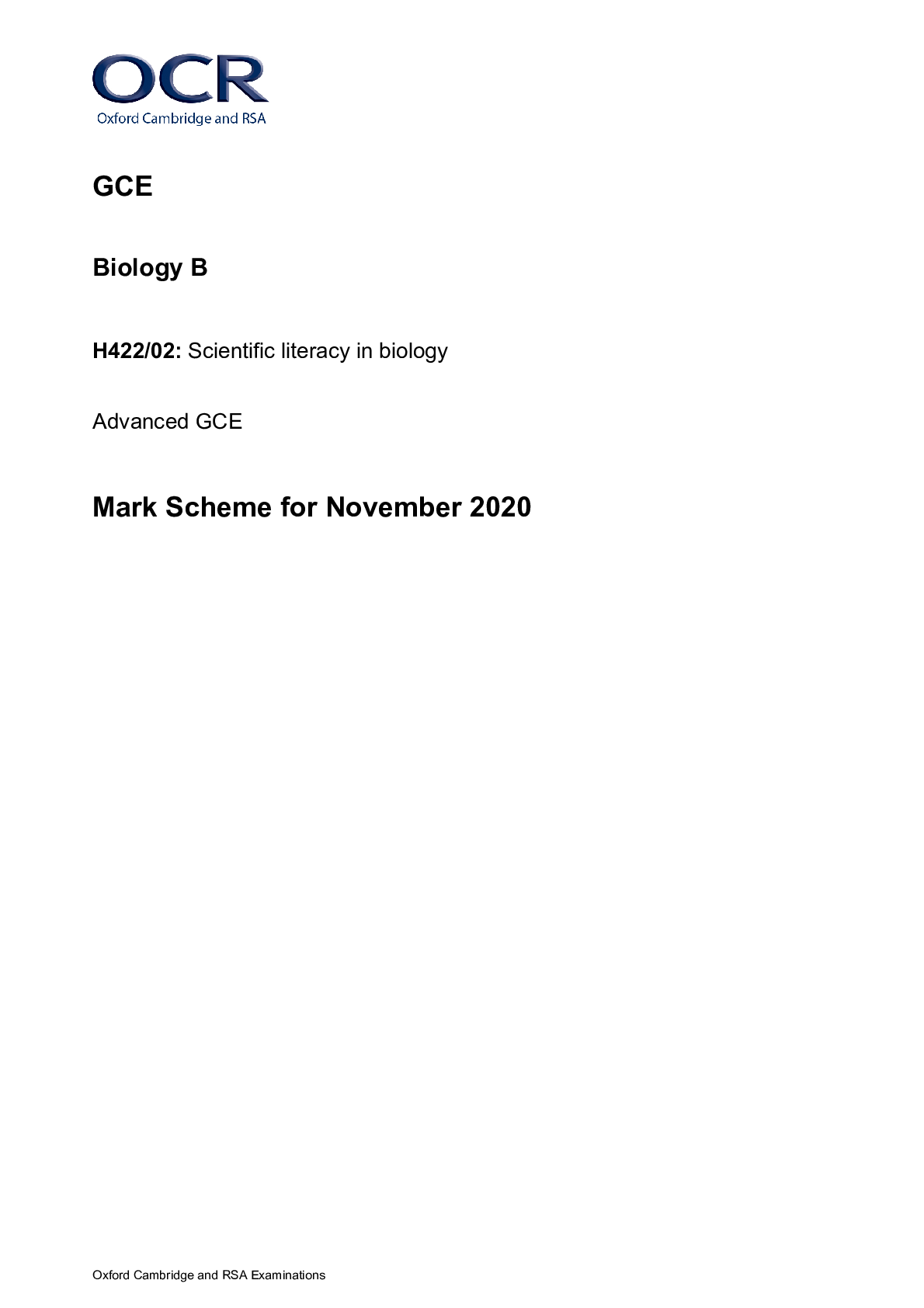
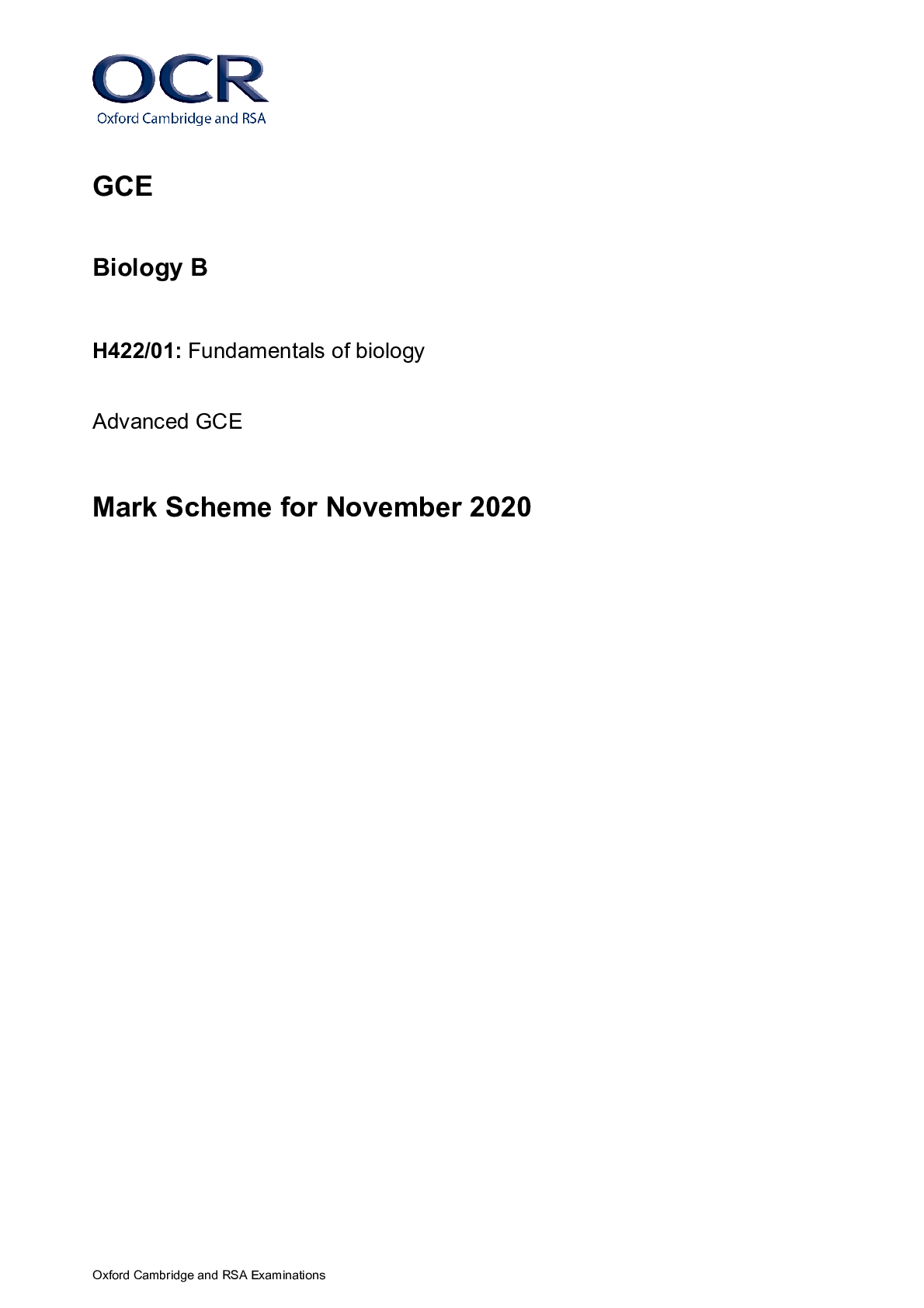

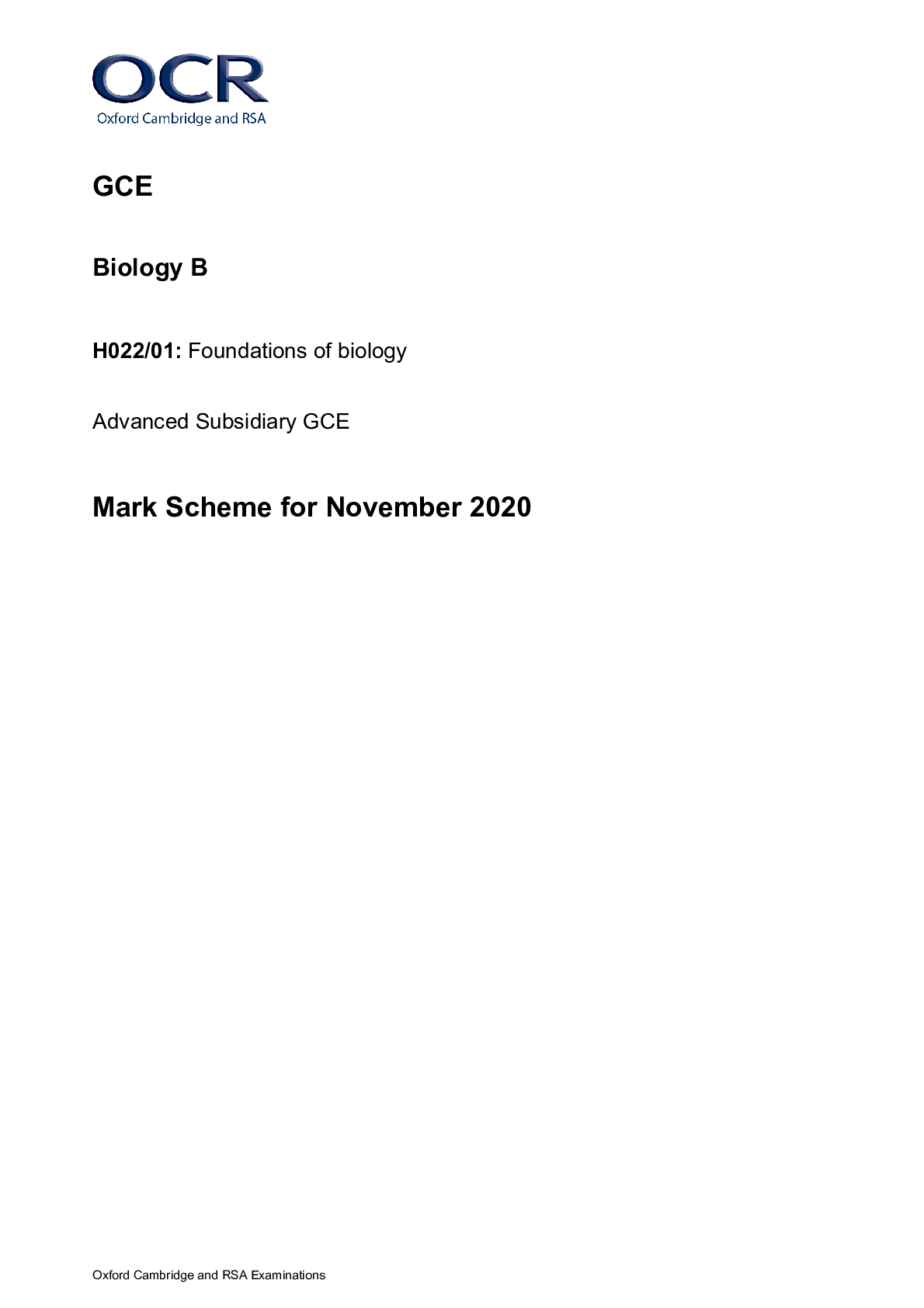
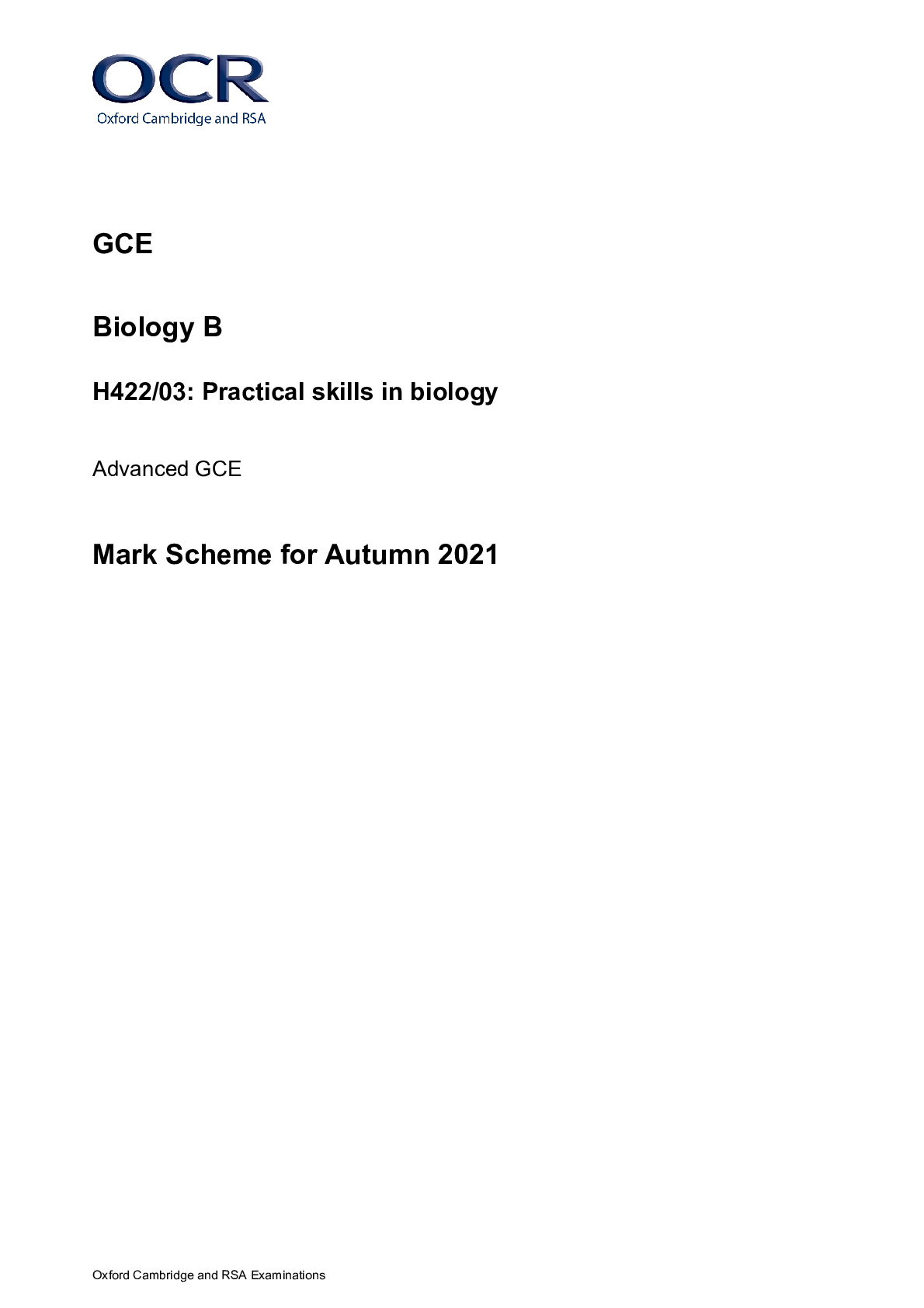
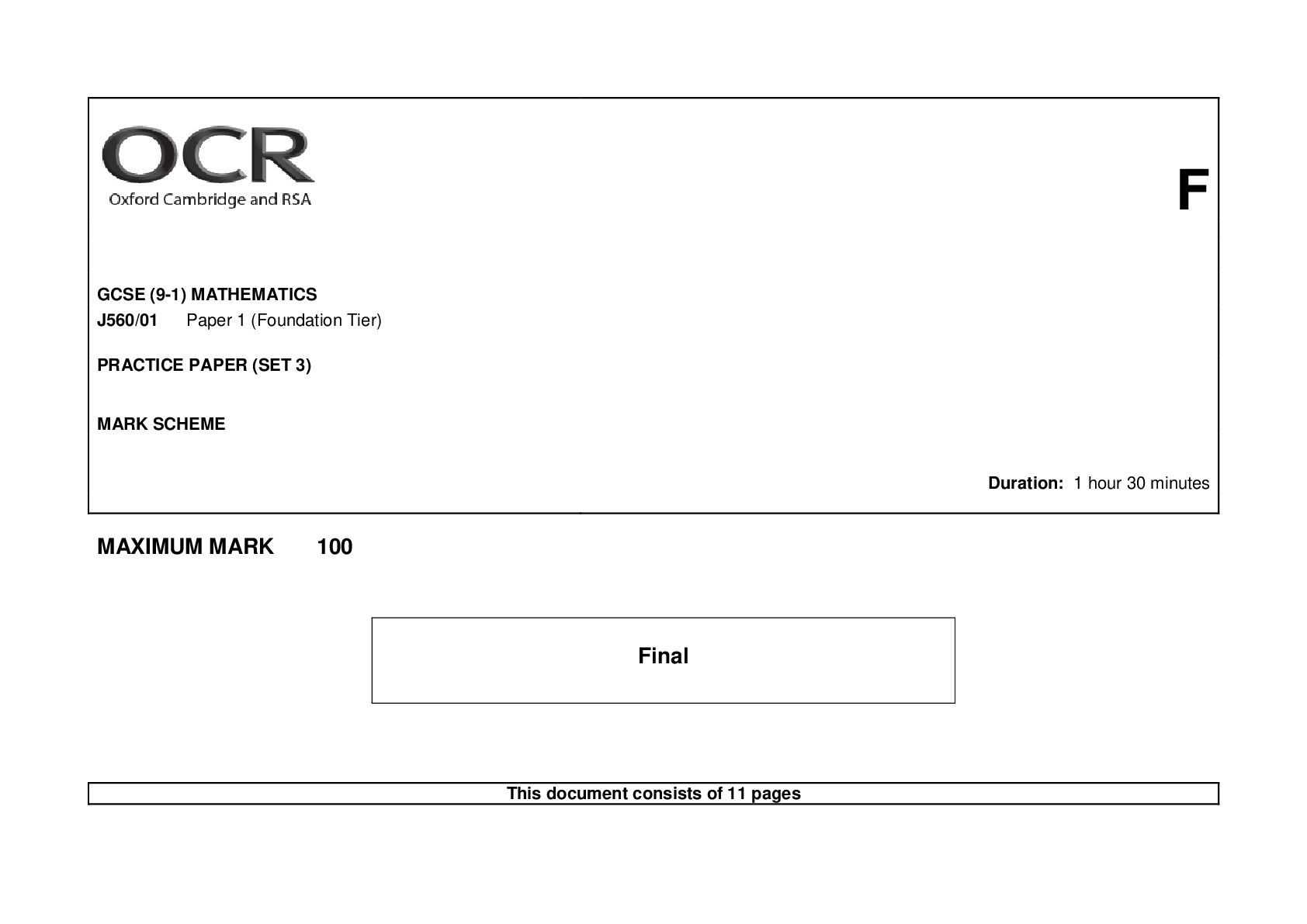
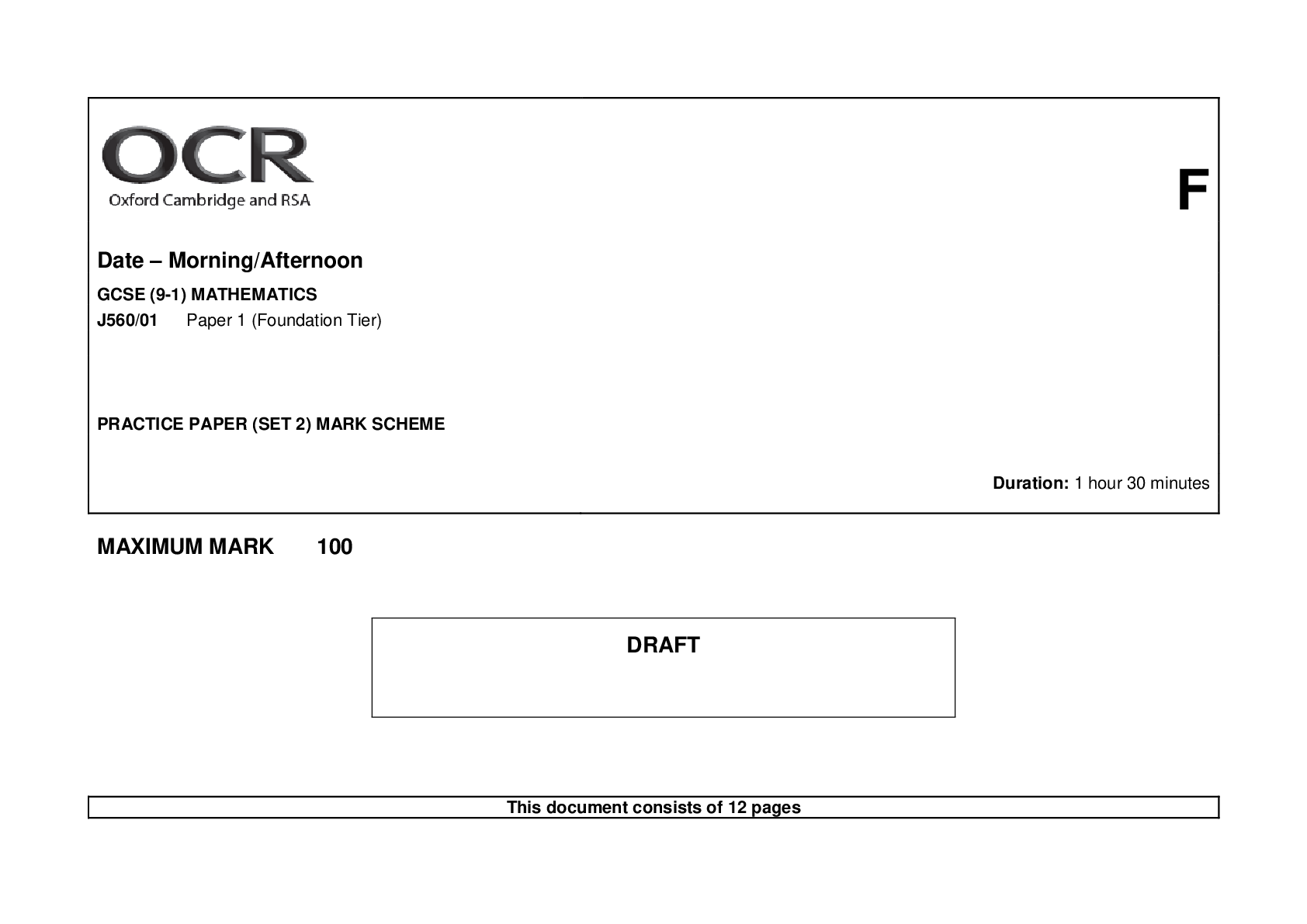
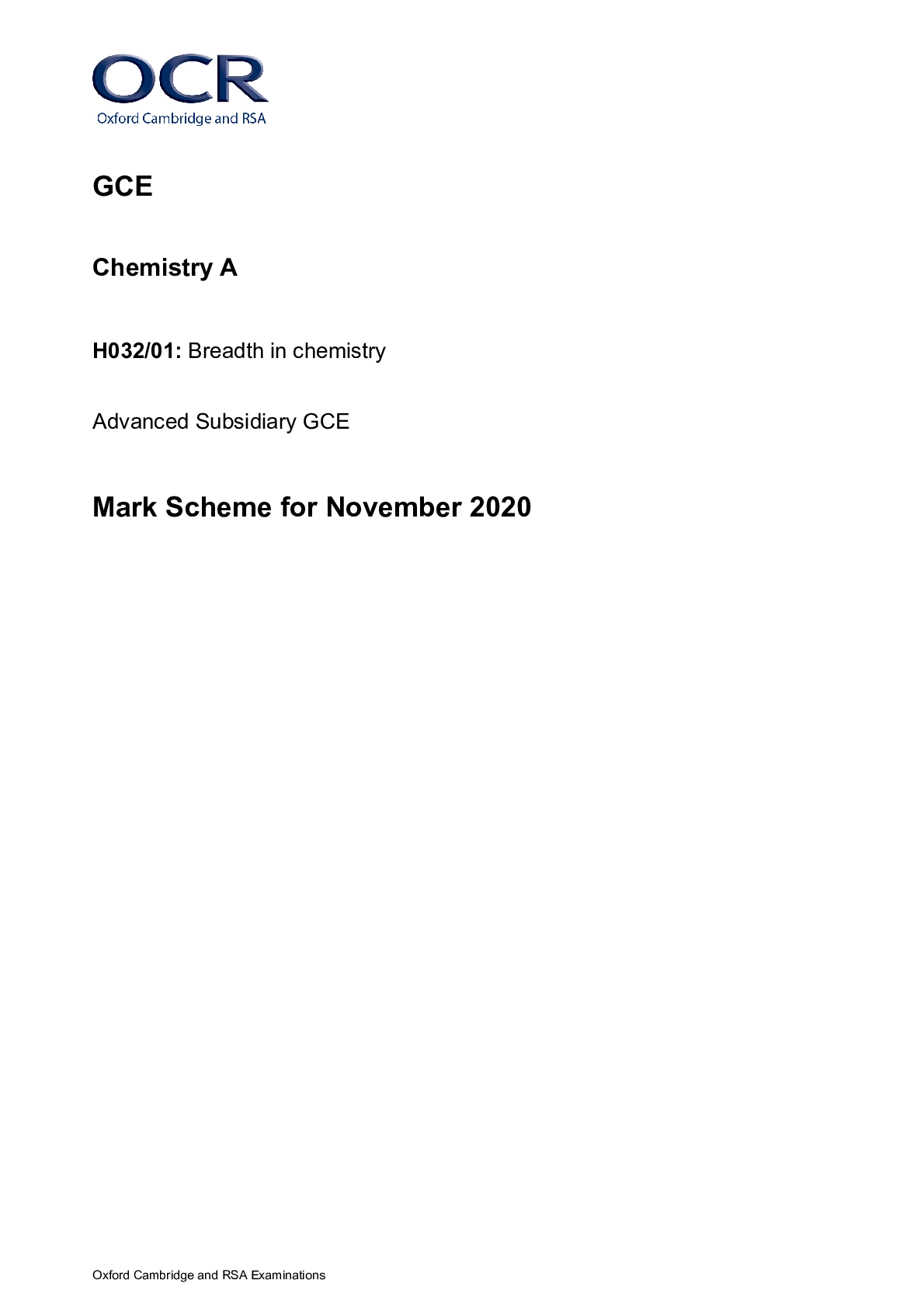

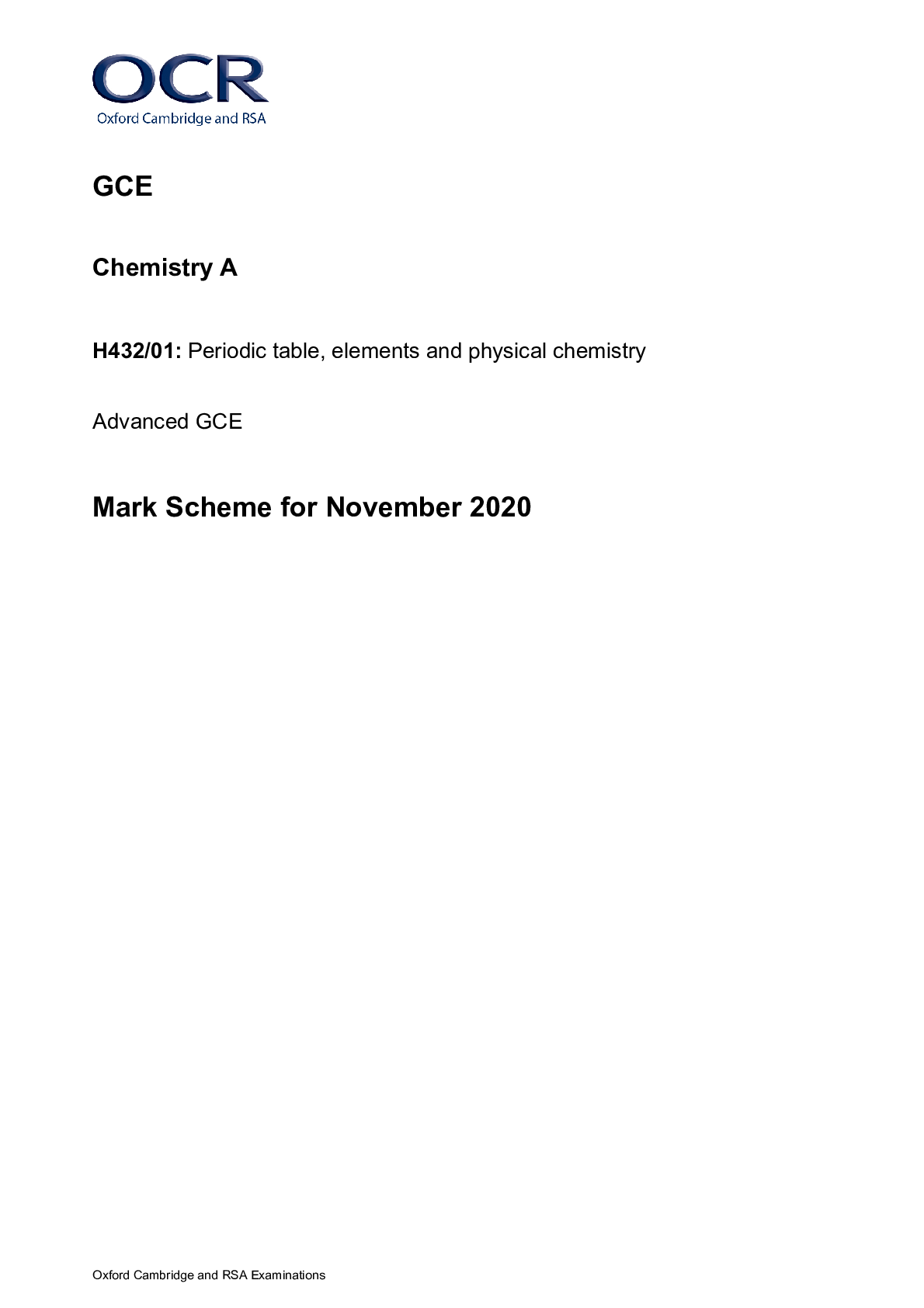
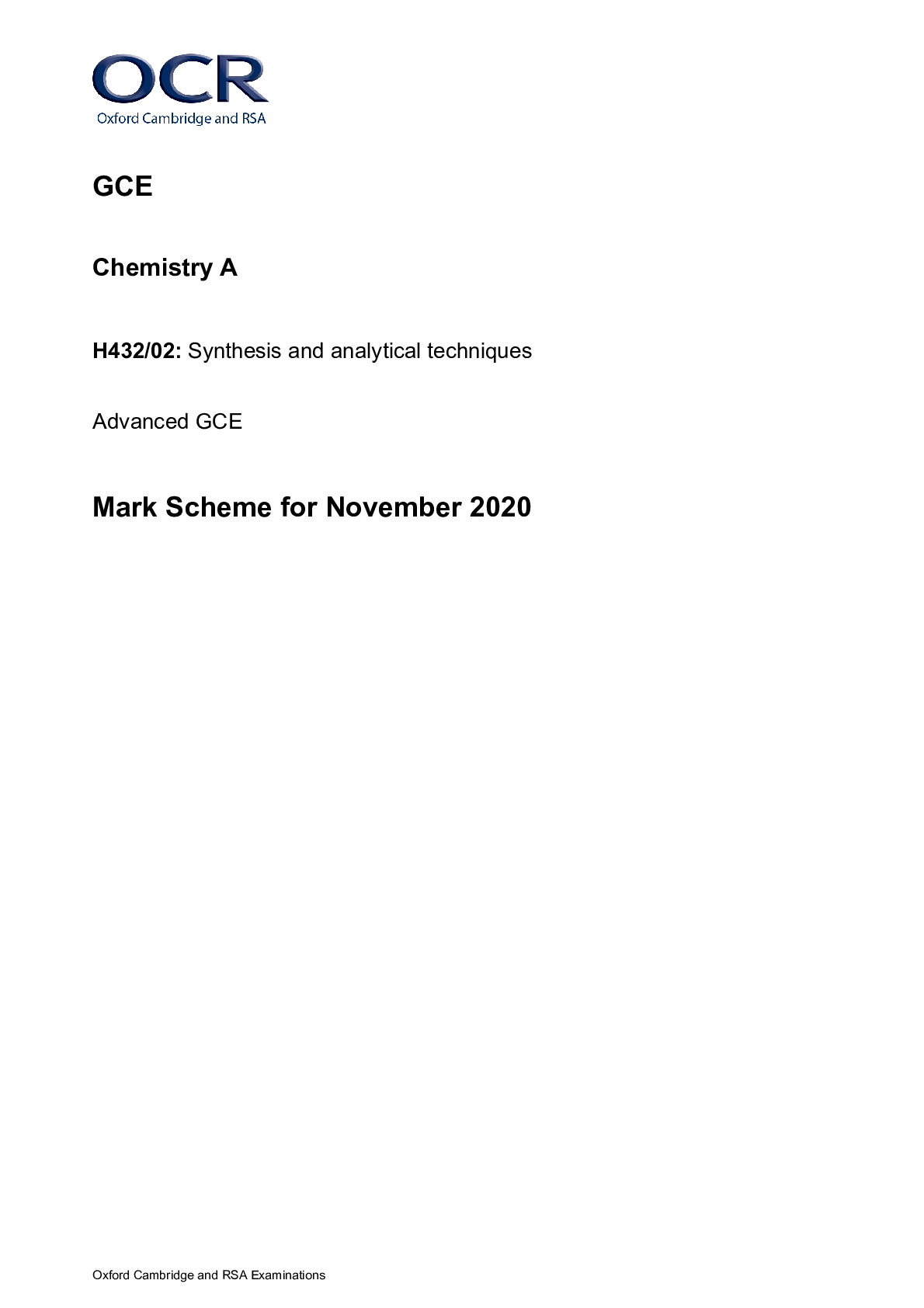

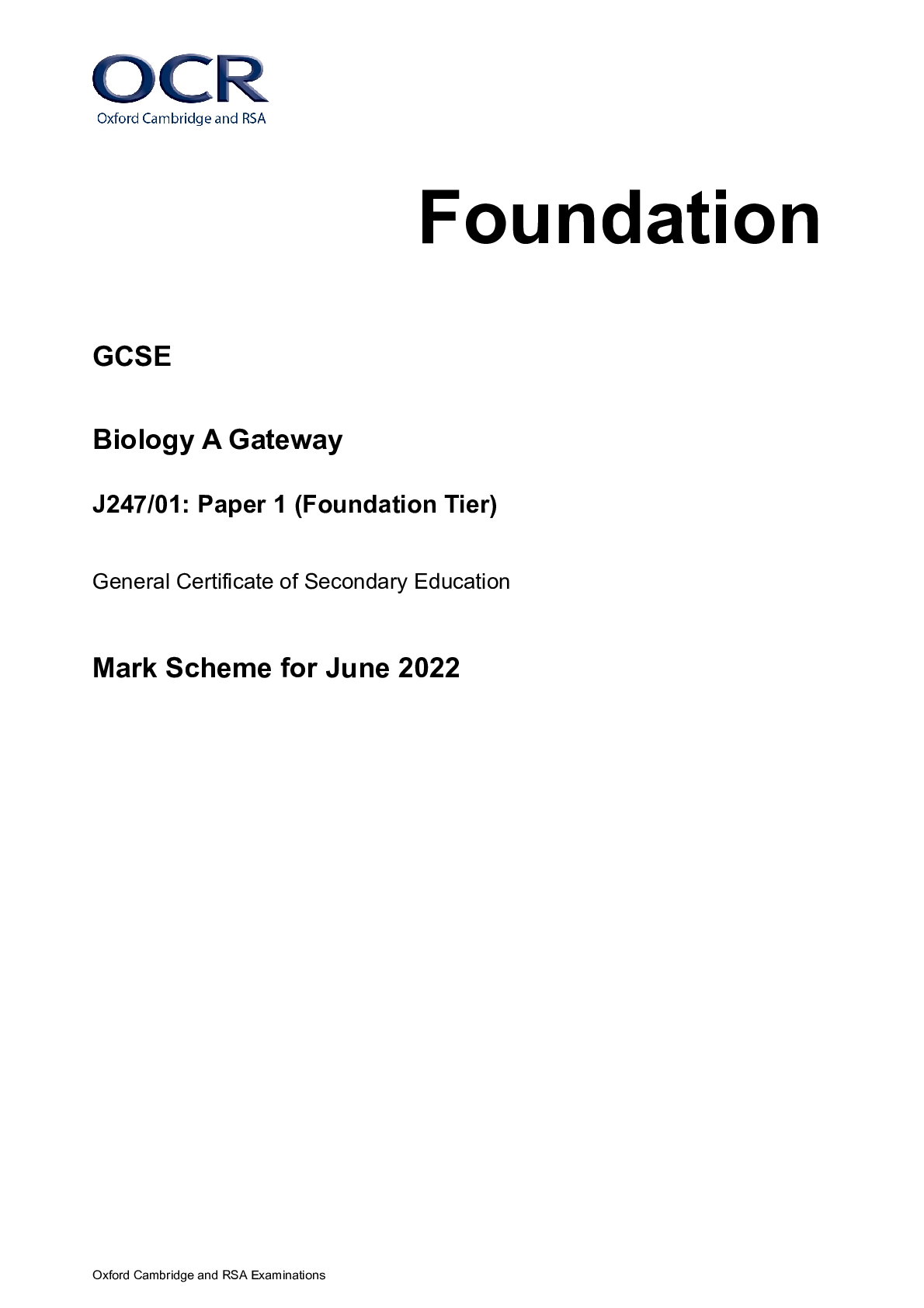


.png)

